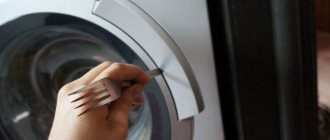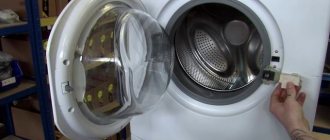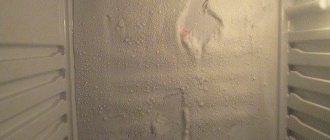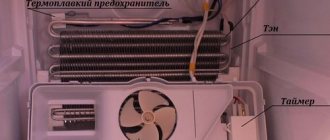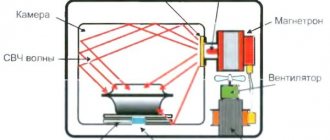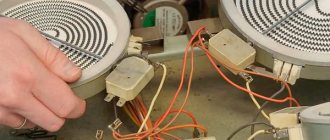Obviously, the refrigerator is one of the most important items in the kitchen. After all, it is thanks to the refrigerator that it is possible to preserve food or cool it for a longer time. In the modern world, not a single housewife can imagine life without this unit. Therefore, it is very important to maintain the refrigerator in working condition, promptly identify and correct any breakdowns. Even if it's just a door that doesn't close tightly. It would seem that what could be terrible about this?
The problem is that the door of the refrigerator ensures its tightness, which allows the temperature inside to remain low for a long time. If the refrigerator door does not close tightly, the entire unit will soon fail. Because in order to maintain a low temperature, if the door breaks, the cooling system will have to work continuously, which will significantly increase its wear and therefore reduce the service life of the refrigerator.
Reasons associated with equipment failure
Reason No. 1. The seal is broken
The seal is a rubber gasket that runs around the perimeter of each outer refrigerator door. Often there is also a magnet inside the seal, which allows the door to fit more tightly to the refrigerator. If not properly cared for, rubber can quickly fail, causing loss of elasticity, drying out, and cracking. This, in turn, can lead to rupture of the seal itself. At the rupture points, cracks form through which warm air enters the refrigerator.
Reason No. 2. The door is deformed
If the door is, for example, warped or dented, this may prevent a tight seal. This may, of course, not be entirely obvious at first glance, but if you take a closer look, everything will be clear. After all, most often refrigerators have a glossy surface, which perfectly highlights all the curves on a flat surface.
Reason #3: Loops
Like any doors, refrigerator doors are held on hinges. If the hinges are not properly maintained for a long period of time, the refrigerator door may become difficult to open and close, which may result in the door not closing properly.
Reason No. 4. Spacer element
The spacer element is the part that ensures the door opens sufficiently. Externally, it is presented in the form of an arc made of plastic or metal. If this part becomes loose and fails, you may notice that the refrigerator door is pushed away from the body.
Main causes of the problem
If the refrigerator door does not close well, then you need to look for the reason. Here are the most common:
- The tightness has decreased due to the accumulation of dirt and grease on the seal.
- The spacer is cracking due to age.
- An uneven floor places the device at an angle.
- The seal has worn out causing cracks.
- The door is too loaded, so changes have been made to the design.
- The spacer is uneven due to loosening.
If nothing interferes with the refrigerator door from inside the chamber, and it is installed correctly at the floor level, then there is some kind of malfunction that prevents the door from closing.
Almost every product is equipped with a sensor with an audible signal. It could fail, resulting in false information about the connection density. Now we should look at all the main reasons in more detail.
The door open signal may be triggered due to incorrect operation of the mechanical switch or reed switch, as well as due to a short circuit in the buzzer control circuit.
Rubber compressor
This is an important element of the entire structure. When washing the entire device, you should pay special attention to cleaning this part. Dirt can be the first cause of a loose seal.
If on any part of the door the rubber does not adhere tightly to the body of the refrigerator when closing, you can try to fix the problem yourself.
The first thing to do is wash the seal. With a low degree of contamination, the process will go quickly. After a few hours it will dry, which means it will begin to perform its functions correctly. There is no need to wash it with strong chemical detergents (for example, those intended for cleaning the oven or sink).
If the seal has a small tear, you can carefully glue the damaged area using instant glue.
Copes well with dirt:
- water with soda;
- vinegar;
- ordinary dishwashing detergent.
Note! If dirt and grease are ingrained, it is easier to purchase a new part than to try to wash it.
The occurrence of many problems with the seal is often associated with improper care and insufficient care of your refrigerator.
Fastenings
If the test with paper shows that poor fixation is occurring, then the loops need to be corrected. They could become loose after a long period of use. By tightening the hinges the position of the door will be restored.
Sometimes it is impossible to close the door tightly due to its sagging. If you often place heavy bottles on door shelves, then this may well happen.
Plastic spacer
A loose spacer will indicate that the doors are moving towards the floor. The defect often occurs in outdated devices. The element is placed at the bottom of the refrigerator (the junction of the main part with the door), but it breaks. It is not difficult to identify this breakdown. You need to see if the door pushes back when closing. If yes, then the problem is definitely in the spacer.
The hallmark of a loose strut is that the door is offset to the floor. This problem occurs in old refrigerators, since over time the spacer element, which is located below, at the junction of the door and the base of the unit, breaks.
Additional information: the door will close if you lift it and then quickly slam it.
To prevent the structure from being damaged, this important part should be replaced.
If the refrigerator door does not close, you need to replace the spacer element, otherwise it may simply fall off.
Overload
This is a common reason that few people think about. To eliminate this problem, you can simply shift not all, but some of the products lying in special shelves on the side. The door will begin to do its job again.
Move some of the food on the door shelves and it will work again.
If a positive result does not occur, then the spacer must be checked. Due to prolonged overload, it could have been damaged.
Close the door gently and carefully - slamming it suddenly breaks its tightness.
Troubleshooting Sealing Problems
Various malfunctions associated with leaks occur. Therefore, there are also several solutions. This needs to be looked into in more detail.
Door misalignment or forced deformation causes an irreversible effect of changing the shape and volume of the rubber seal.
Restoring the seal
The part looks like an elastic band; it helps to tightly close the door with the main part of the device. First, you can try to restore it at home. There are several ways:
Using a hairdryer, unplug the refrigerator and then start heating the rubber band (about eighty degrees Celsius). Afterwards, all sagging areas are straightened out with gloved hands.
Do not open the refrigerator door immediately after it is closed. If you've tried this, you know it takes a lot of effort. You need to wait for some time and then open the door smoothly, without excessive effort.
The part will cool while closed. This method is effective only for small deformations.
Boiling water - remove the gum and place it in a container with very hot water. It will begin to swell, which will lead to a tight closure.
If the problem appeared after transporting the refrigerator, the door itself could have become deformed. Sometimes you can fix this with adjustments. If the damage is significant, the door needs to be replaced.
Steam is a gentle method. To begin with, the door is completely removed and placed on the floor. To generate steam, you can use an ordinary iron or a steam generator. Of course, you can’t iron the rubber; gauze is placed on it, and then the irregularities are straightened out with steam. If necessary, you can apply mechanical pressure with an iron on the most difficult areas to completely level them.
Important! Modern technology is equipped with rubber attached to an adhesive composition. Removal is very difficult, sometimes incorrect handling of the element will lead to more negative consequences. Removing the seal from a Soviet product is much easier (fastening is bolts).
Replacing the seal
Ideally suited rubber can be installed in just a couple of minutes, without any foaming agents or glue. Simply pull the seal onto the door, starting from the top, and push the protruding part of the rubber into the groove.
Some situations require complete replacement of the part. Here are the detailed instructions:
- Prepare everything you need - glue, screwdriver, new tires.
- Turn off the equipment (wait half an hour before further actions).
- Removing the old part with a screwdriver.
- Unscrewing the bolts.
- Cleaning the surface (soap solution, sponge).
- Stretching rubber along the contour of the doors. After inserting it into the channel, it should be secured with special glue. Afterwards it is warmed up with a hairdryer (ordinary household hairdryer, construction hairdryer).
- Checking what has been done - the unit will open with force. If suction does not occur, then there is no closure density (then it is necessary to correct the mistakes made).
If the model does not allow for permutation, you should not try to do it yourself. To avoid serious problems, leave everything as is or turn to professionals.
Correcting skew
This problem can be eliminated by completely reversing the doors.
The elastic must be the correct size, it must be cut vertically and then connected to the horizontal parts. The resulting joints must be secured with glue or adhesive.
Detailed instructions:
- Disconnection from the network.
- If possible, the upper or lower cover is removed.
- Removal - unscrewing the lower and then the upper bolts with a screwdriver.
- Reweighing - call for help, as the part is heavy. Move it to the opposite side, start screwing in the bolts (first the top, then the bottom). The resulting holes are corrected with plugs.
- Checking the work done.
In many cases, simple negligence and lack of care are to blame for rapid door failure.
Reasons not related to equipment breakdown
Reason No. 1. Seal contamination
Thanks to the seal, tightness is ensured. If the seal has not been cleaned for a long time, it will inevitably become dirty. If the accumulations of dirt are too large, they will certainly begin to interfere with the door closing tightly.
Reason No. 2. The refrigerator is not installed correctly
The problem is that not much attention is paid to the installation of the refrigerator, and the most important criteria for placement are that it fits well into the interior and does not interfere. But there is one more very important nuance. The refrigerator must be installed level. So, if the refrigerator is installed tilted forward, it is quite difficult to ensure that its door closes tightly.
Reason #3: The stem is too close
The rod is a part for lighting the refrigerator chamber. In modern models, a defect due to incorrect installation is rarely found, but you should not exclude it. If the door seems to push back when closing, the reason may be that the rod is too close and needs to be moved.
Reason No. 4. Placing dishes inside
There are often cases when a plate that is too wide simply does not allow the door to close tightly, resting its sides against the back wall. Therefore, before sounding the alarm, you should carefully check the dishes that are in the refrigerator.
Reason No. 5. Overloading of shelves
On the refrigerator doors there are separate small shelves for storing small items. If these shelves contain too many or heavy items, the door holding the shelves may not close tightly.
Ways to check the tightness of the refrigerator if the door does not close
A refrigerator door that does not fit tightly is a cause for concern, the first “bell” signaling that something is wrong with the device. Although there are cases when the reason may be a drawer that is not fully retracted or a pan handle that extends beyond the boundaries of the space. Therefore, first of all, you should carefully inspect the equipment.
If there are no obstacles to closing, then other verification methods are used:
- The refrigerator must be placed on a flat, hard surface without a slope. The slightest tilt or misalignment can allow air masses to pass from the room inside
- The degree of adherence of the sealing gum to the body can be easily checked using a paper feeler gauge.
Consequences of a leaky door closure
Obviously, one thing that fails can lead to complete breakdown of the refrigerator. Here are some of the not-so-pleasant consequences of a door that is not tightly closed.
Compressor
The compressor is the part of the refrigerator that cools the air inside the refrigeration chambers. The compressor operates intermittently, since under sealed conditions the air does not need constant cooling. If the seal of the refrigerator is broken, there is a constant supply of warm air, which, in turn, does not allow the compressor to cool the air to a certain temperature and forces it to work continuously.
Therefore, if a loose door was not repaired in time, and the refrigerator began to rattle more, this means that the compressor will soon also fail.
Short circuit
If a door that does not close tightly causes the compressor to break down or increase the load on it, a short circuit may occur, which will lead to a fire or the release of harmful elements that are released when the plastic melts.
Food spoilage
If a door malfunction occurs during the warm season, the warm air entering the refrigerator chamber can lead to a fairly high positive temperature, which will certainly lead to spoilage of some food products.
Thermostat failure
The thermostat is the part that controls the temperature in the refrigerator compartment. If the temperature is unstable and warm air comes from outside, the thermostat can easily fail, and after it the compressor will certainly break down, because without a thermostat it will be impossible to determine the temperature in the refrigerator chamber and understand whether cooling is required.
Video: restoring the refrigerator gasket
Restoring the refrigerator gasket
Watch this video on YouTube
Do you want to understand better than others?
- The refrigerator door does not close well Indesit - How to check if the refrigerator closes tightly It happens that the door appears to be closed, but opens too easily. In this case, you need to check the tightness of the closure with a strip...
- Should a refrigerator compressor be hot? What temperature should the refrigerator compressor be - The principle of operation of the compressor In order to understand what heating temperature is critical for the compressor, it is worth understanding its operating principle. During operation it is quite normal...
- Actions to take if a refrigerator under warranty breaks down - From time to time it happens that a refrigerator under warranty breaks down due to a defect beyond the control of the owner, since the equipment was operated in accordance with all the rules...
- What to do if the refrigerator compressor does not turn on. Refrigerator compressor: causes of breakdowns - How a refrigerator works It can be roughly divided into three main parts: the evaporator; capacitor; compressor (consists of a motor and a relay). If one of them does not function, but...
- The refrigerator is very noisy. Why is the refrigerator humming: what to do if it makes noise and rattles - Normal refrigerator sounds Let's start with the fact that any working refrigerator will make various sounds from time to time. This is due to the operating principle. With absence…
Replacing the seal
If the problem is that the seal has ruptured, then it needs to be replaced. Of course, you can contact a specialist who will do this work, but often you can make the replacement yourself.
The first thing to do is turn off the refrigerator.
After turning off, you need to wait about half an hour. At this time, for convenience, you can remove the door and position it horizontally. Next you need to remove the sealing tape using a screwdriver. This must be done carefully so as not to damage the door itself. Then clean the channel under the rubber seal. For cleaning, use a soap solution or a mixture of water and vinegar, depending on the degree of contamination. Afterwards you need to dry the cleaned surface.
After preparing the door, the sealing tape is stretched around its perimeter and installation is carried out. The type of installation method depends on the fastenings provided; it can be glue or self-tapping screws. It is very important to install the whole thing and not in sections. At the end of the installation, everything is thoroughly dried with a hairdryer and an inspection is carried out to ensure that the seal fits tightly when closing the refrigerator. When installed correctly, the door is perfectly attached to the body without gaps.
Prevention of breakdowns
If the door repair was completed successfully and it opens like new, it is important to take care to prevent the problem from returning in the future. To do this, it is necessary to take into account a number of operating rules:
- During routine defrosting and cleaning of the chamber, you need to wipe the seal with a solution based on soap or vinegar.
- When closing the door, you need to be careful and attentive. Sudden movements and slamming with great force will jeopardize the seal.
- Avoid placing heavy cans on door shelves. They lead to overload and structural damage.
There are many reasons why refrigerator doors do not fit tightly. But if you follow simple recommendations, you can completely get rid of this problem and prevent its occurrence in the future.
Adjusting the refrigerator door
There are times when, in order to fix a door, you just need to adjust or rehang it. This, too, most often does not arise difficulties. But it is worth noting that it is better to do the work together, because the doors are quite heavy.
When re-hanging the door, the refrigerator is also left unplugged for 30 minutes. If possible, remove the protective covers at the top and bottom. Next, unscrew the bolts from below using a special screwdriver. Then unscrew the bolts at the top and remove the door. With the help of a partner, the door is placed on the opposite side and secured with bolts, starting from the top. Then they hide the visible holes with plugs and return the protective covers to their original places.
When you can deal with a loose refrigerator door yourself
What most often prevents the refrigerator door from closing? Here is a list of possible reasons.
- Protruding utensils, drawer or protruding food. In the refrigerator compartment, sticking out handles of frying pans and long products most often get in the way: vegetables, vacuum-packed meat or fish. The refrigerator freezer door usually won't close due to the protruding drawer. Check how the food is in the freezer drawers, rearrange it tightly so that nothing sticks out. In the refrigerator compartment, arrange everything along the shelves. Use storage containers or pans with removable handles.
- Incorrect installation. A refrigerator, especially a built-in one, should be tilted backwards or at least level . Then, when closing, the door will press under its own weight. If during installation there is a forward slope, the refrigeration door will begin to move away even without food on its shelves. Check the slope using a level or plumb line. Adjust the angle by unscrewing the legs. You can also use anti-vibration stands for household appliances.
- The door is not adjusted after rehanging. The design of many refrigerators allows you to move the door to the convenient side. But after the rearrangement, mandatory adjustment of the hinges is necessary. Information on how to check and adjust the hinges is in the instructions for the equipment. Look and do as instructed if you changed the door opening direction.
- Lots of products in the compartment on the door. Door shelves in the refrigerator compartment must not be used to store heavy items. When overloaded, the hinges become loose and the door does not fit tightly. Look what's on the door shelves. Place heavy cans, bottles or boxes inside the chamber.
How to prevent a malfunction?
Of course, it is much easier to prevent a refrigerator from breaking than to repair it. What needs to be done to avoid problems with the door?
- When cleaning the refrigerator, pay special attention to the rubber seal. Clean only with mild detergents. After washing, dry thoroughly.
- Do not load the shelves located on the door, as this can lead to misalignment of the axle and hinges.
- Lubricate the hinges with special oil at least once every three years.
- When opening the refrigerator door, grasp the handle, not the seal.
- Don't slam the door.
- Stick to the three minute rule. If the door was closed, open it only after this time has elapsed. Since after closing, a pressure difference occurs in the refrigerator chamber, which causes stronger adhesion of the seal. If you open the refrigerator earlier, this can lead to microcracks, which will lead to destruction and breakage of the seal.
- If you suspect a breakdown of any part, make timely diagnostics.
- Entrust repairs of increased complexity to professionals.
Very often, the rules for caring for home appliances seem too boring. Everyone thinks that such breakdowns are not about them. However, this is not at all true. Even the newest equipment models are susceptible to breakdowns if not properly maintained.
That is why it is important not to ignore the rules for using home appliances and to take proper care of them. It is much more profitable to keep the equipment that you have in order than to constantly purchase new ones or carry out repairs without understanding your mistakes.
If there is a suspicion that any part is broken, it is very important to identify the reasons in a timely manner. As it turns out, in the case of a refrigerator door, this is not so difficult, you just have to pay attention and put in a little effort.
Precautionary measures
If your refrigerator door is still a little loose, remember a few simple rules that will help keep your appliances in good working order for as long as possible.
- Wipe the rubber seal regularly and when completely cleaning the system, wash it with a mild soap and dry it thoroughly.
- Do not slam the door or catch the seal when opening.
- Follow the 3 minute rule: If you have already closed the camera, wait 3 minutes before opening it. During this time, the pressure inside and outside will be equal and you will not have to use force to unstick the door.
- Do not overload the shelves so that the hinges and the entire axle do not warp.
- Lubricate the hinges at least once every 3 years. Don't wait for the squeak.
- Leave complex repairs to a professional technician.
If you need urgent help with household appliances in St. Petersburg, call +7.
